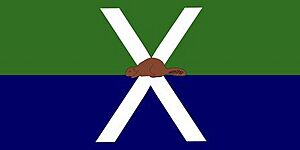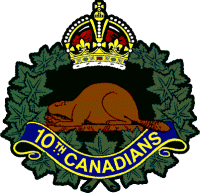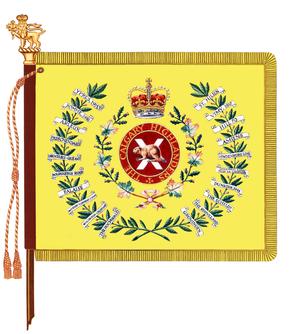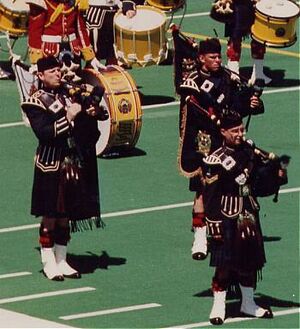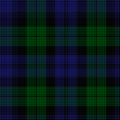Calgary Highlanders facts for kids
Quick facts for kids The Calgary Highlanders |
|
|---|---|

Badge
|
|
| Active | 1910–present |
| Country | Canada |
| Branch | Canadian Army |
| Type | Line Infantry |
| Role | Light infantry |
| Size | One battalion |
| Part of | 41 Canadian Brigade Group |
| Garrison/HQ | Mewata Armoury |
| Motto(s) | Airaghardt (Scottish Gaelic for 'onward') (this spelling is erroneous, the correct spelling is air adhart [ɛɾʲˈɤ.ərˠʃt̪]) |
| Colours | Scarlet with yellow facings (full dress and mess dress) |
| March | "The Highland Laddie" and "Blue Bonnets Over the Border" |
| Anniversaries |
|
| Engagements | |
| Decorations | Canadian Forces' Unit Commendation |
| Battle honours | See #Battle honours |
| Commanders | |
| Colonel-in-Chief | Vacant |
| Honorary Colonel | Lauchlan Currie |
| Notable commanders |
|
| Insignia | |
| Tartan | Government tartan |
| Abbreviation | Calg Highrs |
The Calgary Highlanders are a special part of the Canadian Army. They are an infantry regiment made up of Primary Reserve soldiers. This means they are part-time soldiers who train in their spare time. Their main base is the Mewata Armouries in Calgary, Alberta, Canada.
The regiment is part of the 41 Canadian Brigade Group. This group is part of the 3rd Canadian Division. The Calgary Highlanders are one of only two regiments in Canada that wear a special badge on their uniform. This badge remembers their brave actions at the Battle of Kitcheners' Wood. In 2015, they received the Canadian Forces' Unit Commendation. This award was for their amazing help in the war in Afghanistan.
Contents
Understanding the Regimental Badge
The badge of The Calgary Highlanders is very important. It is based on the badge of the 10th Battalion, CEF. This older battalion is a big part of the regiment's history. A St. Andrew's Cross is a key part of the design.
The crown on the badge shows the reigning monarch. Before 1953, it was a Tudor Crown. After Queen Elizabeth II became queen, it changed to a St. Edward's Crown. People sometimes call these "King's" or "Queen's" Crowns. The beaver and maple leaves on the badge represent Canada. The scrolls with thistles show the regiment's Scottish heritage. The city of Calgary was named after Calgary, Scotland.
You can see this badge in many places. It's on the soldiers' caps, on the regiment's drums, and on the drum major's sash.
How the Regiment Began
The Calgary Highlanders started on April 1, 1910. Back then, they were called the 103rd Regiment "Calgary Rifles". In 1914, many men from the 103rd joined other groups for the Canadian Expeditionary Force. The most famous was the 10th Battalion, CEF.
Over the years, the regiment changed its name and structure. In 1920, it became The Calgary Regiment. Then, in 1924, it split into two separate regiments. One of these became The Calgary Highlanders. They officially carry on the history of the 10th Battalion, CEF.
Fighting in Major Wars
The First World War Experience
When the First World War began in 1914, men from the 103rd Regiment helped protect local areas. The 10th Battalion (Canadians), CEF was formed in August 1914. They went to Britain and then to France in 1915. They fought bravely as part of the 2nd Canadian Infantry Brigade.
Other battalions, like the 56th and 82nd Battalions, CEF, also played a role. They sent reinforcements to help the Canadian Corps. The Calgary Highlanders remember and honor all three of these battalions.
The Second World War Journey
The Calgary Highlanders became an active service unit in September 1939. They trained in Calgary and Manitoba. In 1940, they sailed to England. They joined the Second Canadian Division there. A special mortar platoon from the battalion took part in the Dieppe Raid in August 1942.
In July 1944, the battalion landed in France. They fought across North-West Europe until the war ended. During the Dieppe Raid, two sergeants, Lyster and Pittaway, were recognized for shooting down German planes. Sergeant Clarence "Ken" Crockett was also honored for his bravery in 1944. After the war, the regiment chose the Battle of Walcheren Causeway for an annual remembrance.
After the Wars: Peacekeeping and Training
After 1945, The Calgary Highlanders continued to train soldiers. In the 1960s, their focus shifted to national disaster training. By the 1970s, they returned to training for combat.
In the 1980s, they trained with Grizzly Infantry Fighting Vehicles. Soldiers even went to NATO exercises in Germany and Norway. After the Cold War ended, the regiment returned to a light infantry role.
The Calgary Highlanders have sent hundreds of soldiers on peacekeeping missions. These missions have been all over the world. They also sent 55 soldiers to the Canadian mission in Afghanistan in 2008.
Special Events and Recent History
In 1990, Queen Elizabeth II presented the unit with a new queen's color. This was a special ceremony held at McMahon Stadium in Calgary. The largest peacetime mission for the regiment happened during the 2013 Alberta floods. Over 100 Calgary Highlanders helped with flood relief.
For their service in Afghanistan, the regiment was awarded the Battle Honour "Afghanistan" in 2014. They sent over 100% of their strength to the mission. They also received the Canadian Forces' Unit Commendation in 2015.
Regimental Connections and Traditions
Alliances with Other Regiments
The Calgary Highlanders used to have a special alliance with The Argyll and Sutherland Highlanders (Princess Louise's) from the British Army. This alliance ended in 2006 when the Argylls joined a new regiment. Future connections with British regiments will need to be re-established.
 United Kingdom – The Argyll and Sutherland Highlanders
United Kingdom – The Argyll and Sutherland Highlanders
Battle Honours: Recognizing Bravery
Battle honours are special awards given to military units for their bravery in battle. The ones in bold are displayed on the regiment's flag.
First World War Honours
- St. Julien (This includes the famous counter-attack at Kitcheners' Wood)
- Mount Sorrel
- Somme, 1916
- Arras, 1917, '18
- Hill 70
- Ypres, 1917
- Amiens
- Hindenburg Line
- Pursuit to Mons
Second World War Honours
- Bourguébus Ridge
- Verrières Ridge–Tilly-la-Campagne
- Falaise
- Antwerp–Turnhout Canal
- The Scheldt
- Walcheren Causeway
- The Rhineland
- The Hochwald
- Groningen
- North-West Europe, 1944–1945
Southwest Asia Honours
- Afghanistan
Special Dress and Uniforms
The Calgary Highlanders wear unique uniform items. These show their Scottish heritage and connections.
- Headdress: They wear a red and white checkered glengarry hat. Pipers wear black ones. For combat, they wear a khaki tam o'shanter or balmoral.
- Ceremonial Dress: For special events, they wear a green jacket called a coatee. The Pipes and Drums wear green or scarlet doublets.
- Highland Dress: They wear kilts in the Government tartan pattern. They also wear different types of sporrans (pouches) depending on their rank.
- Combat Dress: In their combat uniform, they wear "CALG HIGHRS" titles on their slip-ons.
Regimental Traditions
The regiment celebrates its birthday on April 1st. This marks the day it was founded in 1910. They also celebrate St. Julien's Day around April 22nd. This remembers the 10th Battalion's role in the Battle of St. Julien. On October 31st, they remember their part in the Battle of Walcheren Causeway.
Important People from the Regiment
Many notable individuals have served with The Calgary Highlanders:
- General John de Chastelain: He was a piper in the regiment before becoming the Chief of the Defence Staff for Canada.
- Lieutenant-Colonel J.G. McQueen: He was the first commander of the Canadian part of the First Special Service Force (also known as The Devil's Brigade).
- Lieutenant-Colonel Mark Tennant: He rose through the ranks during the Second World War. After the war, he commanded the regiment and later became an alderman for Calgary.
- Sergeants Lyster and Pittaway: They were recognized for shooting down German planes during the Dieppe Raid.
- Scruffy Wallace: He was a piper in the regiment before joining the famous band Dropkick Murphys.
Places that Remember the Regiment
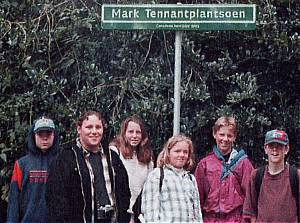
There are several monuments and plaques that honor The Calgary Highlanders.
- In Doetinchem, Netherlands, a city park is named "Mark Tennantplantsoen." This park honors Lieutenant-Colonel Mark Tennant and the soldiers who fought there in 1945.
- The Calgary Soldiers' Memorial lists the names of all Calgary area soldiers who died in war. It includes sections for the 10th Battalion, CEF, and The Calgary Highlanders.
- You can find regimental plaques at places like Mewata Armouries, Hill 67, and Loon Plage in Normandy.
Associated Army Cadet Corps
The Calgary Highlanders are connected to several Army Cadet corps. These groups help young people learn about the military and develop leadership skills.
- 2137 RCACC (Calgary Highlanders)
- 3125 Chestermere RCACC (Calgary Highlanders)
- 3016 Airdrie RCACC (Calgary Highlanders)
- 2383 Foothills RCACC (Calgary Highlanders)
Regimental Museum
You can learn more about The Calgary Highlanders at The Military Museums.
Film Portrayals
The regiment and its history have been shown in movies:
- The Devil's Brigade (1968): Some characters wear the Calgary Highlanders' insignia.
- Legends of the Fall (1994): A character clearly wears the insignia of the 10th Battalion, CEF.
- Passchendaele (2008): This film is inspired by a soldier from the 10th Battalion, CEF.
- The Forgotten Battle (2020): This movie shows the crossing of the Walcheren Causeway.
Images for kids
-
"Government sett", also known as the Black Watch tartan.


